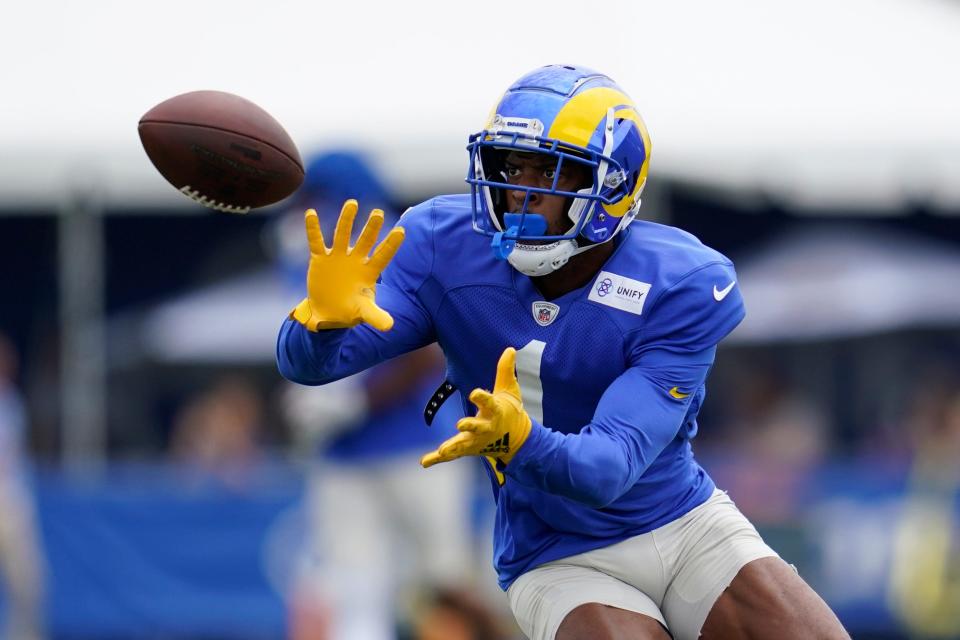Mueller: Robinson brings Steelers solid veteran presence, but on-field expectations should be tempered

The Steelers’ offseason of Doing Things Differently continued last week, when Omar Khan swung yet another deal. The biggest surprise wasn’t that it was a name-brand player coming to Pittsburgh in the deal, but rather that it wasn’t another guard.
Former Penn State star Allen Robinson II was acquired from the Rams for $5 million and a swap of 17 spots in the seventh round; the Steelers sent pick 234 to Los Angeles and got pick 251 in return.
It was a small price to pay for a player routinely cited as a suffering wide receiver, someone whose full talents have never been on display, thanks to the poor quarterbacks – Blake Bortles and Mitch Trubisky, to name two – throwing him the ball. Or, attempting to, at least.
The immediate reaction to the trade from Steelers fans was overwhelmingly positive. On one hand, I get it. On the other, I wonder how much people are being seduced by name recognition.
Robinson hasn’t been “Allen Robinson” since 2020. His last two seasons have been derailed by injury, in the case of last season, and the growing pains of playing with rookie Justin Fields the season prior.
Those that lamented Robinson’s plight while toiling with the Bortleses and Trubiskys of the world figured that 2022 would bring a breakout. He was going to the defending Super Bowl champions, he would get to play beside Cooper Kupp, one of the league’s best receivers, and have rocket-armed Matthew Stafford throwing him the ball. I would count myself among that group. It felt like a “rich get richer” arrangement.
It never worked out. Stafford played hurt most of the year, Kupp was lost to injury, and Robinson struggled to find his niche, even before all of that happened.
Truth of the matter is, if the Rams thought that vintage Robinson was likely to re-appear this year, they either wouldn’t have traded him at all, or would have demanded a higher price. But retaining $10 million of a player’s $15 million salary, and only jumping 17 spots in the last round of the draft suggests they were ready to cut bait no matter what, and wanted to scrounge whatever return they could. The Rams do things differently than most, but their front office isn’t dumb. That tempers any real optimism I have about Robinson’s potential impact.
Even a diminished version of Robinson isn’t without positives, though. According to The Athletic’s Jourdan Rodrigue, who covers the Rams, Robinson was hamstrung by not being able to play catch and build a rapport with Stafford in the offseason, and that he was often the last progression in Los Angeles’ offense.
She indicated that Robinson’s best role would be the slot, which would make the Steelers, who seem to prefer bigger, more physical targets in that position – see JuJu Smith-Schuster – the perfect match.
What’s more, he seems like a home run in the always-important – sometimes too important – area of “locker room presence.” Rodrigue indicated that, despite his struggles for the defending champs, Robinson was a consummate professional, day in and day out.
That has some value for a Steelers wide receiver corps whose most accomplished player, Diontae Johnson, is more the quiet type, who could probably use a veteran to take some media responsibilities off his hands while he tries to bounce back from a down year in 2022.
Also, the rest of the receiver room, at least as of now, consists of George Pickens, who should no doubt benefit from Robinson’s experience, and Calvin Austin, who hasn’t taken an NFL snap. So yes, Robinson’s reputation as a great teammate and wise veteran ought to be helpful.
That said, this trade had better not discourage the Steelers from prioritizing wide receiver with one of their first five picks. It’s a misconception that the team can find wide receivers “anywhere” in the draft. Antonio Brown being a sixth-round pick skews the collective opinion on that matter. Brown aside, none of the Steelers’ notable non-first round finds at the position have been that late.
Mike Wallace was a third-rounder. So was Emmanuel Sanders. Martavis Bryant, if you want to call him a find given how short his career was, came in the fourth. Chase Claypool, whose greatest long-term value might end up being this year’s 32nd pick, was a second-round selection.
If I were in Omar Khan’s shoes, I would try to find another receiver with the 80th pick, or the 120th, at the very latest. Robinson’s best-case scenario is as a productive third wide receiver, but ideally a fourth. That sort of outlook shouldn’t change the calculus with this year’s draft.
Trading for Allen Robinson II brought the Steelers a player with name recognition and a reputation, albeit one that’s a few years out of date. He’ll be good in the locker room and a good mentor to young players. If he ends up bringing them significant production, Omar Khan will have pulled quite the fast one on the Rams.
This article originally appeared on Beaver County Times: Mueller: Robinson brings Steelers solid veteran presence, but on-field expectations should be tempered

